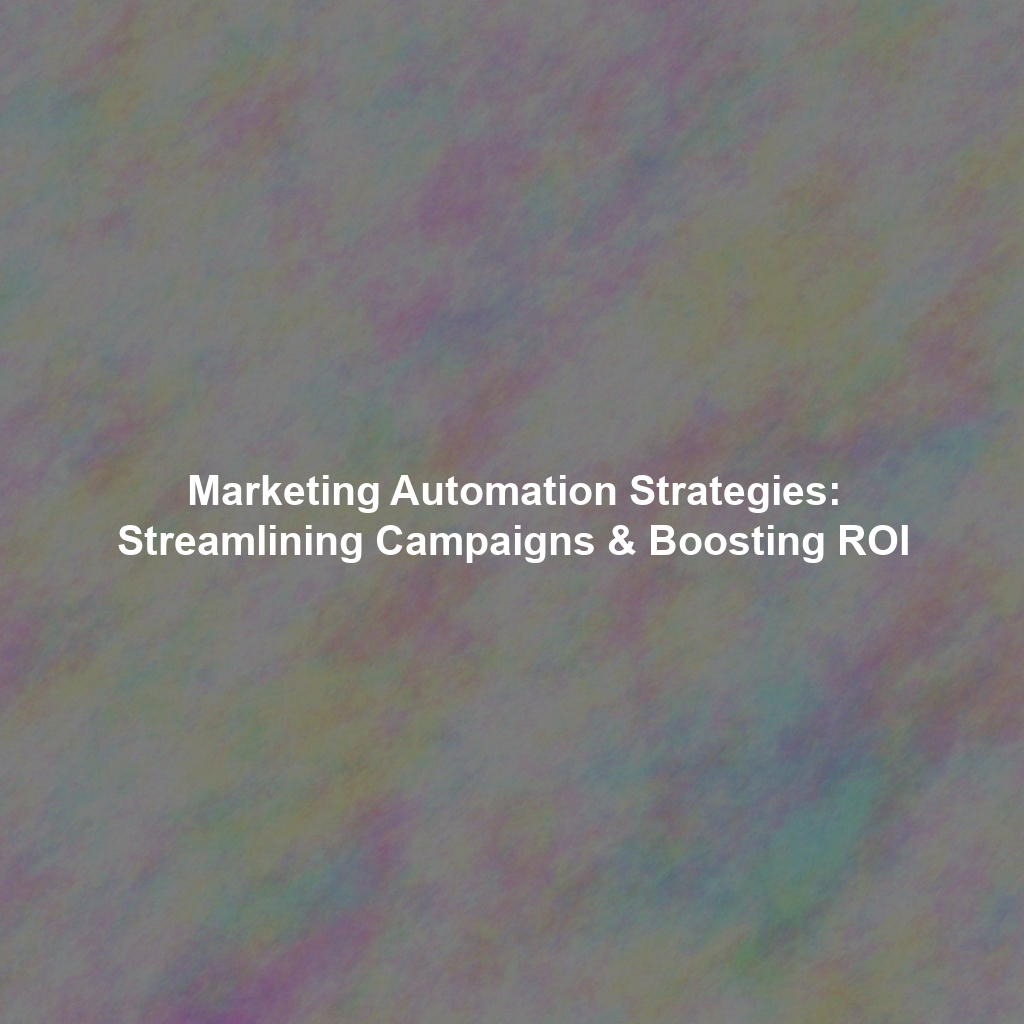This article will delve into the core strategies of marketing automation, providing you with actionable insights and practical examples to implement in your own marketing efforts. We’ll explore key concepts, discuss the benefits, and equip you with the knowledge to unlock the full potential of automation.
Understanding the Core Components of Marketing Automation
Before diving into specific strategies, it’s crucial to understand the building blocks of marketing automation. These components work together to create a cohesive and effective system.
1. Customer Relationship Management (CRM) Integration
Your CRM is the central hub of your marketing automation efforts. It houses valuable customer data, including contact information, purchase history, interactions, and demographics. Integrating your marketing automation platform with your CRM ensures that all your marketing activities are aligned with your customer data, allowing for highly personalized and targeted campaigns.
Why it’s important: Without CRM integration, your automation efforts will be scattered and less effective. You’ll lack the insights needed to personalize communications and segment your audience effectively.
2. Email Marketing Automation
Email remains a powerful marketing channel, and automation elevates it to new heights. Automated email workflows allow you to send targeted messages based on specific triggers, such as website visits, form submissions, or purchase activity. This includes welcome emails, lead nurturing sequences, promotional offers, and transactional emails.
Why it’s important: Email marketing automation allows you to nurture leads at scale, deliver personalized content, and drive conversions with timely and relevant messages.
3. Landing Page Optimization
Landing pages are designed to capture leads and guide visitors towards a specific action, such as signing up for a newsletter or requesting a demo. Marketing automation can help you personalize landing pages based on visitor behavior and demographic data, increasing conversion rates.
Why it’s important: Personalized landing pages create a more engaging experience for visitors, increasing the likelihood of conversion and improving the overall effectiveness of your marketing campaigns.
4. Lead Scoring and Segmentation
Lead scoring assigns points to leads based on their behavior and characteristics, helping you identify the most qualified prospects. Segmentation allows you to group leads based on similar attributes, enabling you to deliver highly targeted messages.
Why it’s important: Lead scoring and segmentation ensure that your marketing efforts are focused on the most promising leads, maximizing your chances of conversion and improving ROI.
5. Multi-Channel Marketing
Modern marketing is no longer confined to a single channel. Marketing automation allows you to orchestrate campaigns across multiple channels, including email, social media, SMS, and web personalization. This ensures a consistent and cohesive customer experience, regardless of the channel they interact with.
Why it’s important: Multi-channel marketing allows you to reach your audience where they are, delivering a consistent and personalized experience across all touchpoints.
Key Marketing Automation Strategies to Boost ROI
Now that we’ve covered the core components, let’s explore some specific marketing automation strategies that can drive significant ROI.
1. Lead Nurturing: Guiding Prospects Through the Sales Funnel
Lead nurturing involves building relationships with prospects by providing them with valuable content and information that addresses their needs and pain points. Automated lead nurturing workflows can guide prospects through the sales funnel, from initial awareness to final purchase.
Example: A prospect downloads an e-book from your website. This triggers a series of automated emails that provide additional resources, case studies, and testimonials, gradually building trust and credibility.
Key Benefits: Increased lead quality, improved conversion rates, and shorter sales cycles.
2. Personalized Email Marketing: Delivering Relevant Content at Scale
Generic email blasts are a thing of the past. Marketing automation allows you to personalize email content based on individual preferences, behaviors, and demographics. This includes personalizing subject lines, body copy, and offers.
Example: An e-commerce company sends personalized product recommendations based on a customer’s past purchases and browsing history.
Key Benefits: Higher open rates, increased click-through rates, and improved customer engagement.
3. Behavioral Triggered Emails: Reaching the Right People at the Right Time
Behavioral triggered emails are sent based on specific actions that a prospect or customer takes. This could include visiting a particular page on your website, abandoning a shopping cart, or downloading a specific resource.
Example: A prospect visits your pricing page but doesn’t fill out a contact form. An automated email can be triggered offering a free consultation or a special discount.
Key Benefits: Increased conversion rates, improved customer satisfaction, and reduced cart abandonment.
4. Customer Onboarding: Ensuring a Smooth and Successful Experience
Customer onboarding is the process of guiding new customers through the initial stages of using your product or service. Automated onboarding workflows can help customers get started quickly, understand key features, and achieve their desired outcomes.
Example: A software company sends a series of automated emails and in-app messages that guide new users through the setup process and highlight key features.
Key Benefits: Reduced churn, increased customer lifetime value, and improved customer satisfaction.
5. Cross-Selling and Upselling: Maximizing Revenue from Existing Customers
Marketing automation can be used to identify opportunities to cross-sell and upsell to existing customers. By analyzing purchase history and browsing behavior, you can identify products or services that are relevant to their needs and interests.
Example: A customer purchases a laptop. An automated email can be sent offering a discount on a complementary accessory, such as a laptop bag or a wireless mouse.
Key Benefits: Increased revenue, improved customer loyalty, and enhanced customer relationships.
6. Social Media Automation: Streamlining Your Social Presence
While not the primary focus of all marketing automation platforms, many offer integrations to help schedule posts, track engagement, and even respond to direct messages across various social media channels. This ensures a consistent brand voice and frees up time for more strategic social media initiatives.
Example: Automatically posting blog content updates to Twitter and LinkedIn, or triggering a targeted Facebook ad campaign based on website visitor behavior.
Key Benefits: Consistent brand messaging, increased social media reach, and improved efficiency in managing social media channels.
Choosing the Right Marketing Automation Platform
Selecting the right marketing automation platform is crucial for success. There are many options available, each with its own strengths and weaknesses. Consider the following factors when making your decision:
- Your Business Needs: What are your specific marketing goals and objectives? What features and functionalities are essential for achieving those goals?
- Your Budget: Marketing automation platforms vary in price, from free options to enterprise-level solutions. Choose a platform that fits your budget without compromising on essential features.
- Integration Capabilities: Does the platform integrate seamlessly with your existing CRM, email marketing platform, and other marketing tools?
- Ease of Use: Is the platform easy to learn and use? Consider the user interface, documentation, and support resources available.
- Scalability: Can the platform scale as your business grows and your marketing needs evolve?
Some popular marketing automation platforms include:
- HubSpot
- Marketo
- Pardot (Salesforce Marketing Cloud Account Engagement)
- ActiveCampaign
- GetResponse
It’s highly recommended to take advantage of free trials and demos to test out different platforms and see which one best suits your needs.
Measuring and Optimizing Your Marketing Automation Efforts
Marketing automation is an ongoing process that requires continuous monitoring and optimization. It’s essential to track key metrics and make adjustments based on the results.
Key metrics to track include:
- Open Rates: The percentage of recipients who opened your emails.
- Click-Through Rates: The percentage of recipients who clicked on a link in your emails.
- Conversion Rates: The percentage of leads who convert into customers.
- Lead Generation Costs: The cost of acquiring new leads through your marketing automation efforts.
- ROI: The return on investment generated by your marketing automation campaigns.
Regularly analyze these metrics and identify areas for improvement. A/B test different email subject lines, body copy, and calls to action to optimize your campaigns for maximum performance. Don’t be afraid to experiment and try new approaches. The key is to continuously learn and adapt to changing market conditions and customer preferences.
Conclusion: Embracing Automation for Marketing Success
Marketing automation is no longer a luxury; it’s a necessity for businesses looking to thrive in today’s competitive digital landscape. By implementing the strategies outlined in this article, you can streamline your marketing campaigns, boost ROI, and build stronger relationships with your customers.
Embrace the power of automation and unlock the full potential of your marketing efforts. Start small, experiment with different approaches, and continuously monitor your results. With the right strategy and tools, you can transform your marketing from a reactive process to a proactive and data-driven engine for growth.
Remember that marketing automation is not about replacing human interaction, but about augmenting it. It’s about freeing up your marketing team to focus on strategy, creativity, and building meaningful connections with your audience. By combining the power of automation with the human touch, you can create truly exceptional marketing experiences that drive results.
 Skip to content
Skip to content

